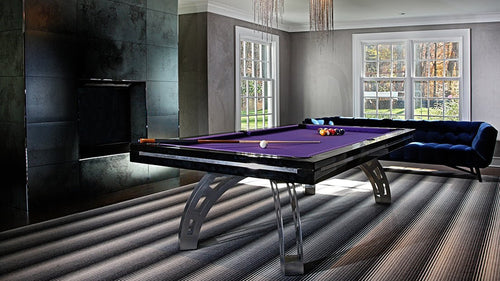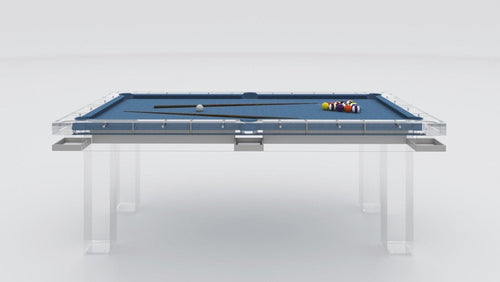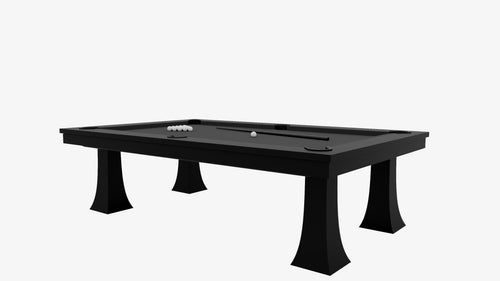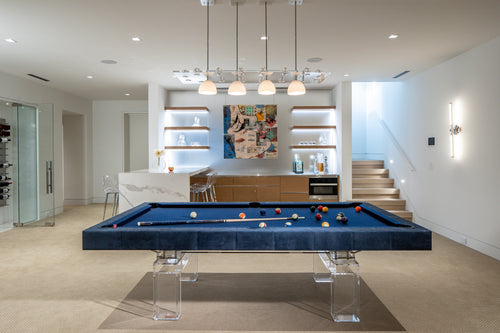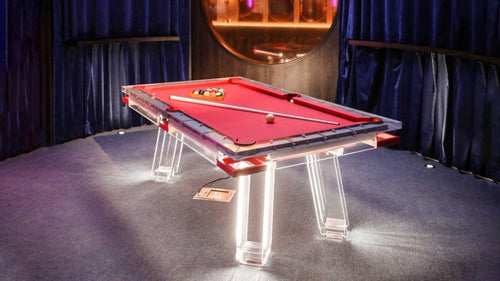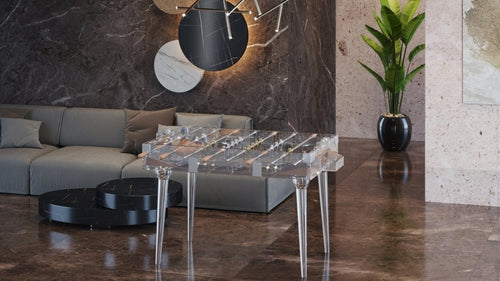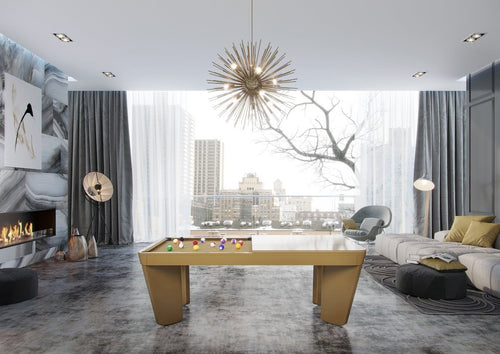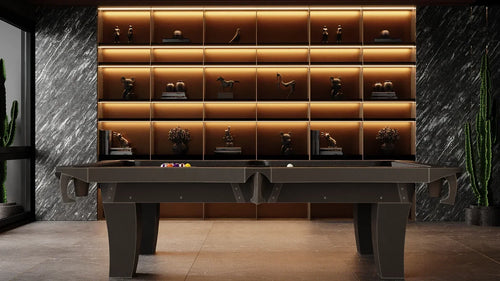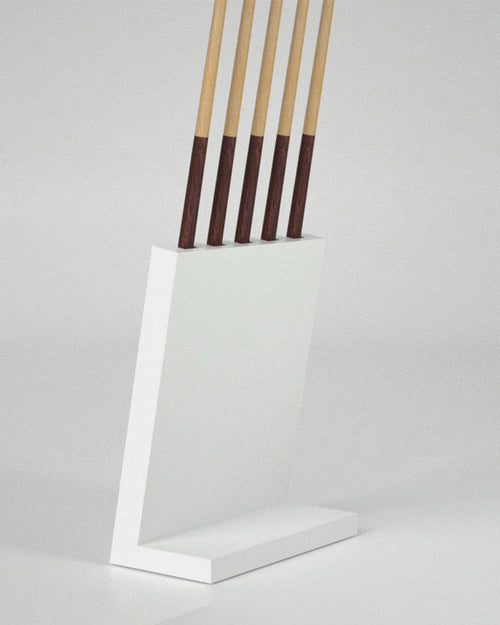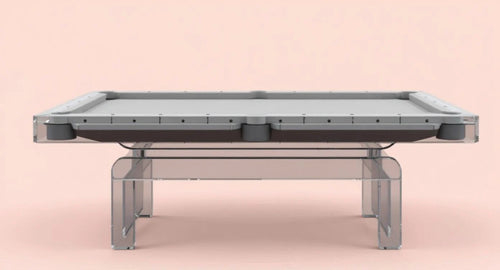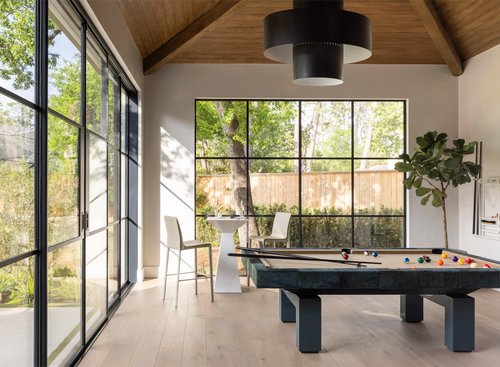Enjoy our modern designs
Why Deco reads right on a billiards table: hard geometry, rich veneers, and metal accents turning a game surface into architecture.
Why Deco belongs in a pool room
Art Deco didn’t just dress skyscrapers and theaters. It changed furniture—hard lines, rich veneers, cool metal—into stage pieces. Put that language on a pool table and you get something rare: a game surface that feels like architecture.
From Deco to Streamline (30 seconds)
- Art Deco (’20s–mid ’30s): sharp geometry, symmetry, exotic woods, lacquer, chrome—luxury with edges.
- Streamline Moderne (mid ’30s–’40s): curves, horizontal “speed” lines, teardrop legs, aluminum—glamour built for the machine age.
That evolution is the whole story: from jewel-box drama to sleek, engineered confidence.
What makes a table read “Deco”
Start with a rectangle on legs. Then:
- Round the corners.
- Step the base or band the apron in clean horizontals.
- Add aluminum or copper trim like jewelry.
- Veneer the faces in Macassar ebony, rosewood, or figured maple.
The silhouette gets faster; the table stops looking heavy and starts looking designed.
The hero pieces (and why they matter)
Brunswick Paramount (late ’30s)
The art-gallery one. Often linked to industrial designer Donald Deskey (Radio City). Stepped base, crisp rectangles, flamed maple or rosewood, copper accents. It’s Deco at full volume without feeling fussy.
Brunswick Moderne (late ’30s–mid ’40s)
The Streamline poster child. Rounded corners, teardrop legs, horizontal banding. It looks like it should move—clean, confident, modern.
Brunswick Anniversary (’45–’46) & Centennial (from ’46)
The machine-age bridge. Aluminum aprons and corner castings paired with walnut/rosewood panels. Anniversaries skew cream-and-walnut; Centennials go darker with “mar-resistant” aluminum. Industrial parts presented like couture.
Materials that do the talking
- Exotic veneers for depth and figure (Macassar, rosewood, bird’s-eye).
- Aluminum, chrome, copper/bronze for edges and armor.
- High-polish lacquer to pull light across planes.
- Geometry—stepped bases, speed lines, chevrons—to telegraph movement.
None of this is fake. The materials are the aesthetic.
Do they play like “real” tables?
Yes—if set up right. Play is slate, rubber, pocket geometry, and install. The Deco is a skin over a serious frame. Properly restored Paramounts, Modernes, Anniversaries, and Centennials run pro-spec just fine.
How to spot the good ones (and dodge the bad)
- Corner castings: originals feel crisp/solid; soft, pitted repros drag the whole look down.
- Apron profile: Streamline aprons should sweep or step—if they look flat, someone sanded away the character.
- Veneer quality: real book-match looks alive; heavy stain is a band-aid.
- Legs: true teardrops taper; chunky replacements kill the silhouette.
- Under the hood: beware coin-op guts stuffed in Deco shells, or “tightened” geometry without checking shelf depth and facing angles.
Restoration that keeps the soul
- Metal: straighten, weld, and refinish aluminum; polish/anodize properly.
- Wood: re-veneer in period species; finish with catalyzed lacquer at a period-correct sheen (glossy, not plastic).
- Rubber & pockets: new K-66, correct facings, measured shelf depth.
- Badges & hardware: find the right nameplates—generic brass screams aftermarket.
Dress the room so it sings
- Light: a frosted linear or halo pendant—warm, even, shadow-free.
- Seating: tubular-steel frames, club chairs, or a waterfall-edge bench.
- Palette: cream + walnut/rosewood, punctuated with chrome or copper; add one saturated hit (teal, emerald, burgundy).
- Walls: framed ’30s travel posters, theatre programs, simple stepped cue rack.
Modern echoes you can buy today
You’re seeing Streamline DNA in new builds: rounded corners, continuous bands, metal trims. Glass or acrylic legs with aluminum rails read like 21st-century machine-age—same confidence, cleaner lines.
Buying smart
- Provenance beats adjectives. Catalog receipts, serials, seller history—get the paper.
- Check castings first. Missing/damaged corners can turn a deal into a wallet fire.
- Price the finish work. Veneer + metal refinish aren’t cheap—get quotes before you fall in love.
- Measure the geometry. Mouths, facings, shelf—numbers, not vibes.
- Plan the move. Crating for castings, pro movers, a tech who knows Deco frames.
Bottom line
An Art Deco pool table is where glamour meets engineering. Speed lines and shiny metal are the theater; true surfaces and tuned geometry are the craft. Nail both, and your table stops being furniture—it becomes a room.



